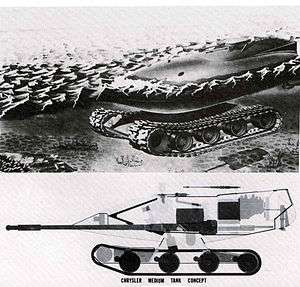Chrysler TV-8
| Chrysler TV-8 | |
|---|---|
|
Concept design of the Chrysler TV-8 | |
| Type | Medium tank |
| Place of origin | United States |
| Specifications | |
| Weight | 25 tons |
| Length | 352 in (8.9 m) |
| Width | 135 in (3.4 m) |
| Height | 115 in (2.9 m) |
| Crew | 4 |
|
| |
Main armament | 90mm T208 gun |
Secondary armament |
Co-axial .30 caliber machinegun ×2 Remote controlled .50 caliber machinegun |
| Engine |
Chrysler V-8 engine Gas turbine engine drive Hydrocarbon-based vapour-cycle power plant Nuclear-powered vapour-cycle power plant |
The Chrysler TV-8 was an experimental concept tank designed by Chrysler in the 1950s. The tank was intended to be a nuclear-powered medium tank capable of land and amphibious warfare. The design was never mass-produced.[1]
Description
The TV-8 was presented in a proposal by Chrysler Corporation subsequent to the ASTRON meeting. Using an unconventional tank design, the proposed tank located the entire crew, engine and ammunition storage within a pod-shaped turret mounted above a lightweight chassis which could be separated for air shipment. The total weight of the tank was approximately 25 tons, with the turret weighing 15 tons and the chassis weighing 10 tons.[1]
Following review, it was concluded that the TV-8 design did not prove to have significant advantages over conventional tank design to warrant further development, and on 23 April 1956, the TV-8 and three ASTRON proposals were effectively terminated.[1]
Power
The phase I design of the Chrysler TV-8 featured a Chrysler V-8 engine with 300 gross horsepower which was coupled to an electric generator located within the rear turret; the generator powered two electric motors in the front hull, each motor driving either of the two 28-inch wide tracks. Other methods of powering the tank that were later considered include a gas turbine engine drive, a vapour-cycle power plant fueled by hydrocarbons, and a nuclear fission-powered vapour-cycle power plant.[1]
Offensive capabilities
The tank was armed with a 90mm T208 gun with a hydraulic ramming device mounted in the turret, with ammunition stored in the rear turret behind a steel bulkhead separating from the crew. Two co-axial .30 caliber machineguns and one remote controlled .50 caliber machinegun on top of the turret were also included. Closed circuit television was implemented as a measure to protect crew from the flash of tactical nuclear explosions and improve field of vision.[1]
Amphibious combat
The design of the tank was intended to allow it to float, with the turret being watertight and fitted with water jet pumps in the rear to allow for propulsion while in water. The turret consisted of two layers, namely an inner and outer shell, with the outer section acting as spaced armour protecting the inside.[1]
Footnotes
References
- Hunnicutt, RP (1990). A History of the American Main Battle Tank, Volume 2: Abrams. United States: Presidio. ISBN 9780891413882.
